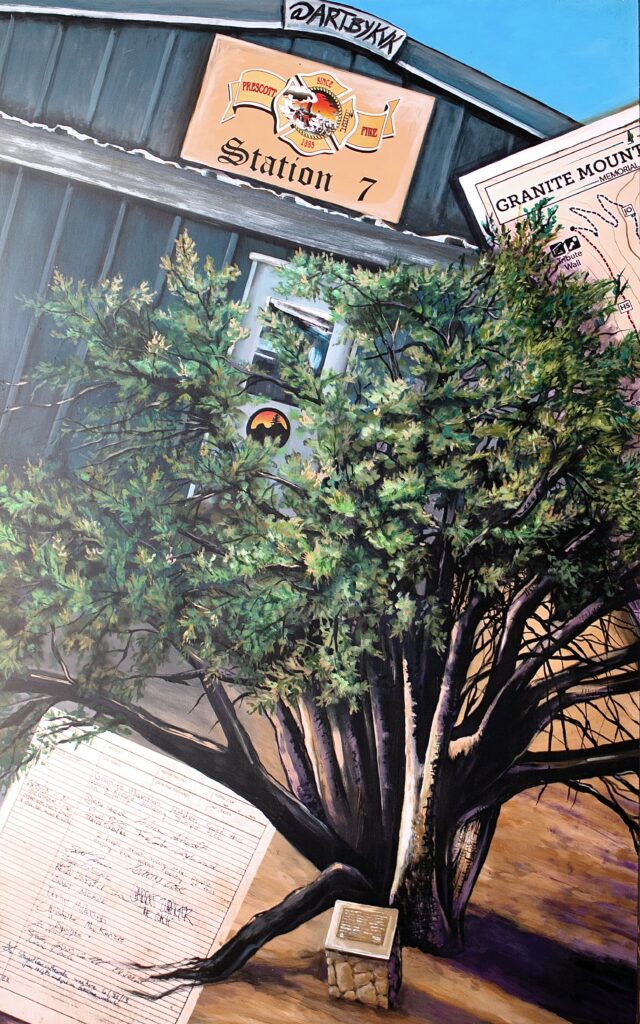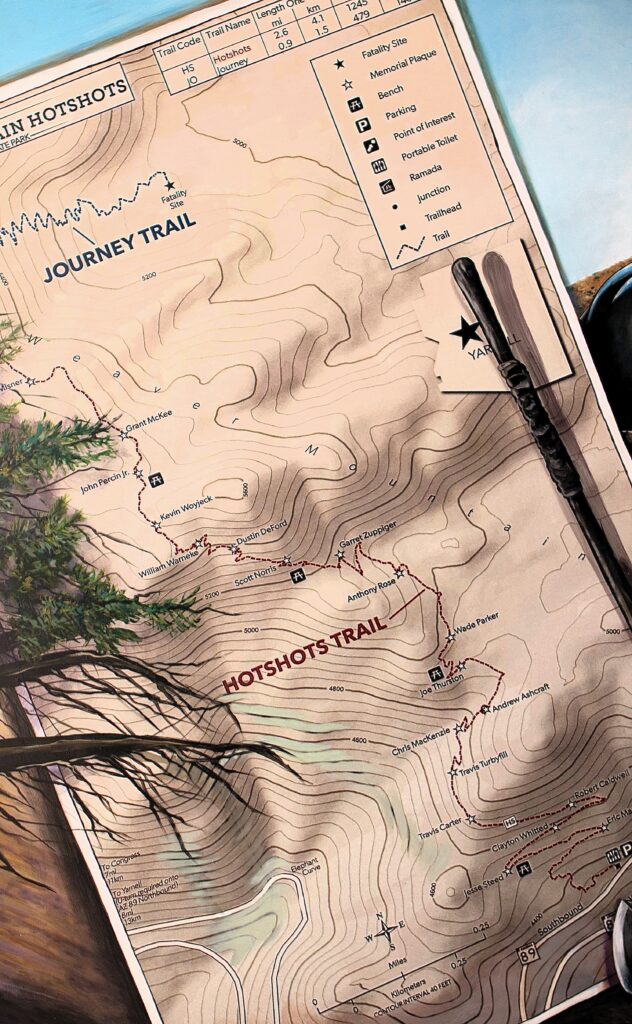


The upper left-hand corner is a visual portrayal of Fire Station 7, where the hotshot team was initially interviewed, hired, and trained to be hotshots. Directly below, the mural depicts the Alligator Juniper Tree, which the hotshots saved on June 16th, 2013. The Alligator Juniper is said to be the state’s oldest living icon, estimated at approximately 1400 years old. Thanks to the 19, this national co-champion alligator juniper was rescued. They ascended the mountain, cleared dense vegetation around the tree’s base, and created a fire line just two weeks before the tragedy. Adjacent to the tree, there is a depiction of the logbook or “journal,” complete with the signatures and recorded entries from many of the crew who undertook to save the tree that day.
The Hotshot Trail Map is also included in the middle of this group of panels. The Granite Mountain Hotshots Memorial State Park was dedicated in 2016 as a place of remembrance for the 19 Granite Mountain Hotshot Firefighters who were lost on June 30, 2013, while fighting the Yarnell Hill Fire. This 2.85-mile trail hike to the observation deck provides a better understanding of the experience of these men as well as a view of the beautiful town of Yarnell and the surrounding areas. Every 600 feet, one of 19 plaques is set into rocks, sharing a photo and a story of each fallen Hotshot. There are also four interpretive signs paired with memorial benches that provide information about wildland firefighting. Further down on the Memorial Trail, you can pay your respects at the site where the Hotshots were recovered. The hike is approximately 3.5 miles long from the trailhead to the Fatality Site.
Next to the map, there is a portrayal of a slurry. A slurry is a mixture of water, fertilizer, and chemicals that is dropped from planes, which is a bright red color, making it visible for aircrews to track where they have previously dropped. Slurry is used on specific areas to slow a fire’s advance, allowing crews to get into an area to build hard lines or fire breaks. There is also a depiction of a non-specific Hotshot here, looking up at the slurry, illustrating what their helmets looked like.
Lastly, in this arrangement of panels, the artist included some of the tools used by the hotshots in fighting wildfire. The tools used each time vary depending on what the fire and terrain demands. The hotshots carry 40-pound packs with these tools on their backs while hiking through rough terrain and sawing down brush. One of the tools, a Pulaski, which is a special hand tool used in wildland firefighting, combines an ax and an adze in one head, with a rigid handle made of wood, plastic, or fiberglass. A Pulaski is a versatile tool for constructing firebreaks, as it can be used to both dig soil and chop wood.
Painted next to the Pulaski is the fire rake, which is used to quickly clear pathways while chopping and raking underbrush weeds and vines. Also included in the group of tools here is a chainsaw. The chainsaw is used to clear fire lines and remove hazardous trees or snags. On every hotshot crew, there are 2-3 saw teams of two people, people who are trained and qualified (certified) to cut down trees with chainsaws amid wildland fires. In addition, on every hotshot crew, there are 2-3 hotshots that carry drip torches. The drip torch, painted last in the group of tools, is an effective tool used for wildfire suppression, controlled burning, and other forestry applications to intentionally ignite fires when needed.
